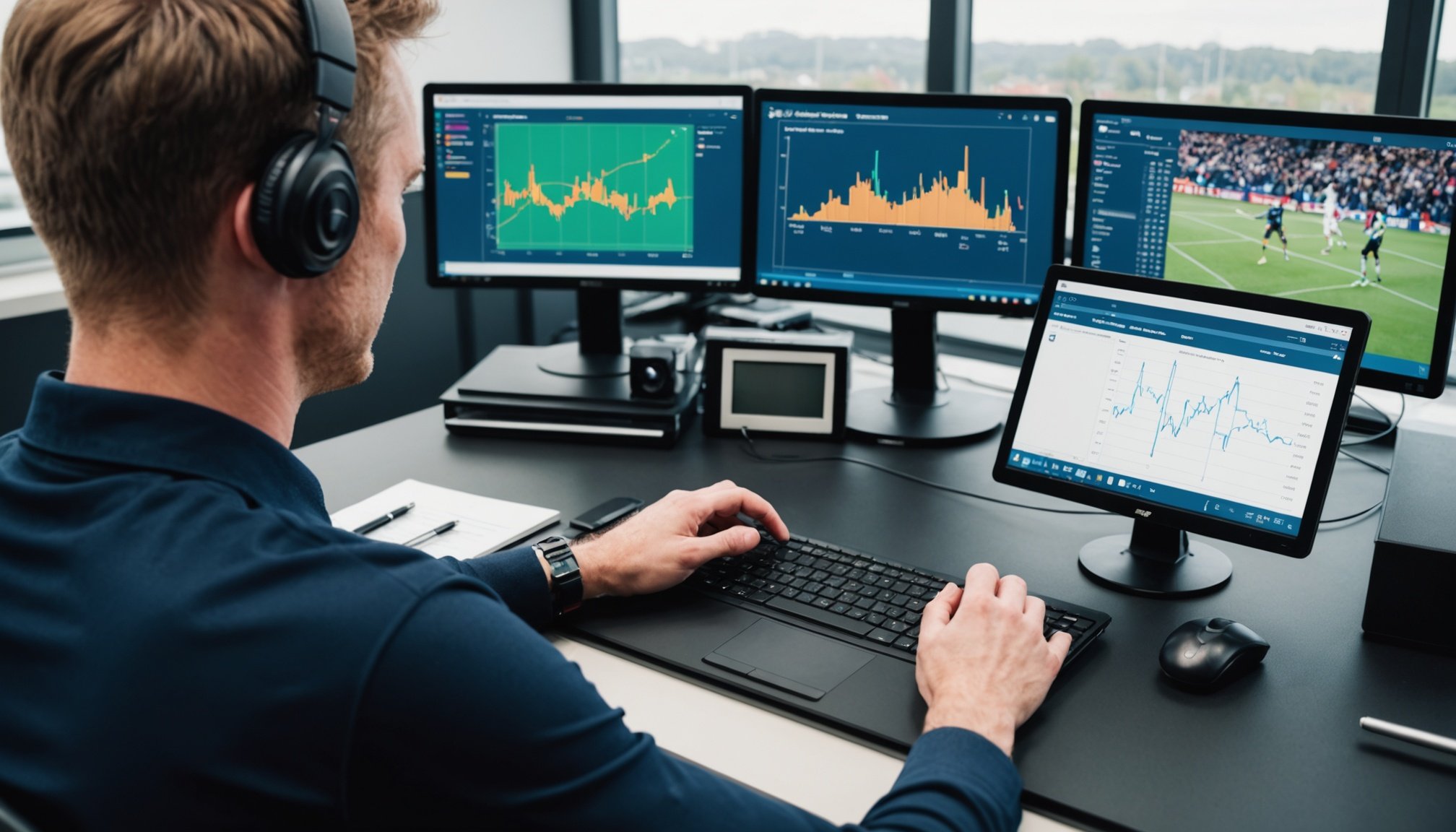Leveraging Technology: A Guide for UK Sports Teams to Monitor and Enhance Performance
In the ever-evolving world of sports, technology has become an indispensable tool for teams aiming to enhance performance, engage fans, and ensure athlete safety. This guide delves into the various technological innovations that UK sports teams can leverage to gain a competitive edge.
The Role of Wearable Technology in Sports Performance
Wearable technology has revolutionized the way athletes train, recover, and perform. These devices have transitioned from being mere novelties to essential tools in the sports industry.
Also read : Best places to stay in alpe d'huez for an unforgettable trip
Types of Wearables and Their Uses in Sports
Wearable devices come in various forms, each serving a specific purpose:
- Heart Rate Monitors: Track cardiovascular activity, helping coaches and athletes gauge intensity levels during training and games[2].
- GPS Trackers: Monitor speed, distance, and positioning on the field, particularly useful in team sports like football and rugby[2].
- Smart Clothing: Equipped with sensors that measure muscle activity, sweat levels, and posture alignment[2].
- Sleep Trackers: Record sleep patterns to ensure athletes get the rest needed for optimal performance[2].
- Biomechanical Sensors: Analyze body movement and mechanics to prevent injuries and improve technique[3].
Case Study: Catapult Sports
Catapult Sports is a pioneer in wearable technology, offering athlete-monitoring solutions that combine GPS, inertial measurement, and heart rate data. Teams in the NBA, NFL, and Premier League use Catapult’s devices to monitor player load and minimize injury risks. The data helps coaches make informed decisions about player substitutions, rest, and training adjustments[2][5].
In the same genre : Top accommodation options in alpe d'huez for your perfect stay
Impact on Athlete Performance
Wearable technology has several key impacts on athlete performance:
- Injury Prevention: Real-time monitoring of exertion levels helps prevent overuse injuries.
- Training Optimization: Data on movement patterns allows for tailored training programs.
- Performance Analysis: Wearables offer metrics on speed, agility, and endurance, providing feedback for continuous improvement[2].
Artificial Intelligence (AI) and Data Analytics: Revolutionizing Performance and Strategy
Artificial intelligence and data analytics are transforming the sports industry by providing deep insights into athlete performance and team strategies.
AI in Performance Analysis
AI plays a crucial role in analyzing data, helping coaches, scouts, and teams gain insights into player performance and strategy. Here are some key areas where AI impacts sports:
- Player Performance Prediction: AI algorithms analyze historical data to predict players’ future performance, allowing coaches to make data-driven decisions[2].
- Injury Risk Assessment: AI can process biomechanical data to identify players at high risk of injury and suggest preventive measures[2].
- Scouting and Recruitment: AI-driven platforms assess player potential, providing a more comprehensive view of talent[2].
Case Study: IBM Watson in Tennis
IBM Watson’s AI-powered analytics have been used in tennis tournaments like Wimbledon, analyzing vast amounts of data to deliver insights on player tendencies, shot selection, and match probabilities. This data enhances not only team strategies but also the fan experience by providing deeper insights into the game[2].
Video Analysis: Enhancing Performance and Tactical Awareness
Video analysis has become a cornerstone in modern sports, offering various techniques to enhance performance and tactical awareness.
Practical Applications of Video Analysis
Video analysis techniques include:
- Motion Tracking: Provides detailed data on an athlete’s movements.
- Pattern Recognition: Identifies recurring strategies or mistakes.
- Tactical Assessment: Coaches review game footage to identify opponents’ strengths and weaknesses, tailoring strategies to exploit these insights[4].
Statistical Evidence of Effectiveness
The integration of video analysis has been quantified through various performance metrics, offering tangible evidence of its effectiveness:
- Teams that have adopted video analysis have shown an average increase of 15% in win rates within a season.
- Basketball teams using video analysis improved their defensive efficiency by 20%, thanks to insights gained from reviewing opponents’ offensive plays[4].
Future Trends in Sports Technology
As technology continues to evolve, several trends are set to redefine the sports industry.
Expanded Use of AI in Training and Scouting
AI could be used to predict not only player performance but also recovery timelines and match outcomes. This will enable coaches and athletes to make informed decisions quickly, enhancing both individual and team performance[2][4].
Greater Fan Personalization
Fans can expect more personalized experiences through apps, VR, and social media. For instance, augmented reality (AR) and virtual reality (VR) can provide immersive experiences, allowing fans to feel closer to the action[2].
Widespread Adoption of Wearable Technology
Wearables will become a staple in amateur and youth sports, making professional-grade insights more accessible. This democratization of technology will help level the playing field and ensure that athletes of all levels can benefit from data-driven training[2][3].
Enhanced Safety Measures
Advances in helmet technology, mouthguards, and wearable sensors will focus on reducing injuries, especially in high-impact sports like football and rugby. For example, Google’s Jacquard insole tracker for football can monitor player movements and detect potential injury risks[1][2].
Integrating Technology into Training Regimens
To fully leverage these technological advancements, UK sports teams need to integrate them seamlessly into their training regimens.
How to Leverage Sports Technology Trends
- AI Coaching Applications: Use computer vision and AI to analyze player techniques, identify strengths and weaknesses, and provide targeted feedback for improvement[1].
- Wearable Technology Integration: Incorporate wearable devices into daily training to monitor athlete performance, health, and training effectiveness[2][3].
- Video Analysis Implementation: Use video analysis to dissect game footage, refine strategies, and improve players’ tactical awareness[4].
Practical Insights and Actionable Advice
Here are some practical insights and actionable advice for UK sports teams looking to enhance their performance through technology:
Data Collection and Analysis
- Use a Variety of Data Sources: Combine data from wearables, video analysis, and other sensors to get a comprehensive view of athlete performance.
- Invest in Advanced Analytics: Utilize machine learning and AI to process vast amounts of data and provide real-time insights.
- Ensure Data Accuracy: Be mindful of the potential discrepancies and challenges in data analysis to ensure the accuracy and reliability of the data generated[3].
Fan Engagement Through Technology
- Leverage Social Media: Use social media platforms to engage fans, provide updates, and offer personalized experiences.
- Implement AR and VR: Provide immersive experiences through AR and VR to enhance the fan experience and increase engagement[2].
Real-Time Feedback and Decision Making
- Use Real-Time Data: Utilize real-time data from wearables and video analysis to make immediate adjustments to training intensity and technique.
- Data-Driven Decision Making: Make decisions based on data analysis rather than intuition, ensuring that strategies are optimized for better outcomes[1][4].: The Future of Sports Technology
The integration of technology in sports is not just a trend; it is a necessity for teams aiming to stay competitive. From wearable technology and AI analytics to video analysis and fan engagement innovations, these tools are transforming the sports industry in profound ways.
As Catapult Sports emphasizes, “With a mission to unlock the potential of every athlete and team, Catapult partners with over 4,200 elite teams across more than 100 countries, spanning 40 different sports”[5].
In the words of a sports analyst, “The future of sports is not just about the game; it’s about the data, the analysis, and the insights that can be derived from it. Teams that embrace this technology will be the ones that succeed in the long run.”
Table: Comparative Analysis of Key Technologies in Sports
| Technology | Key Features | Benefits | Examples |
|---|---|---|---|
| Wearable Technology | Heart rate monitors, GPS trackers, smart clothing, sleep trackers | Injury prevention, training optimization, performance analysis | Catapult Sports, Google’s Jacquard insole tracker |
| AI and Data Analytics | Player performance prediction, injury risk assessment, scouting and recruitment | Data-driven decision making, enhanced strategy, improved fan experience | IBM Watson in Tennis, AI coaching applications |
| Video Analysis | Motion tracking, pattern recognition, tactical assessment | Enhanced performance, tactical awareness, improved win rates | Premier League football clubs, rugby teams |
| AR and VR | Immersive fan experiences, personalized engagement | Increased fan engagement, enhanced fan experience | Sports apps, social media platforms |
By embracing these technologies and integrating them into their training regimens, UK sports teams can unlock new levels of performance, enhance fan engagement, and ensure a safer and more competitive sporting environment. The future of sports is here, and it is driven by technology.






